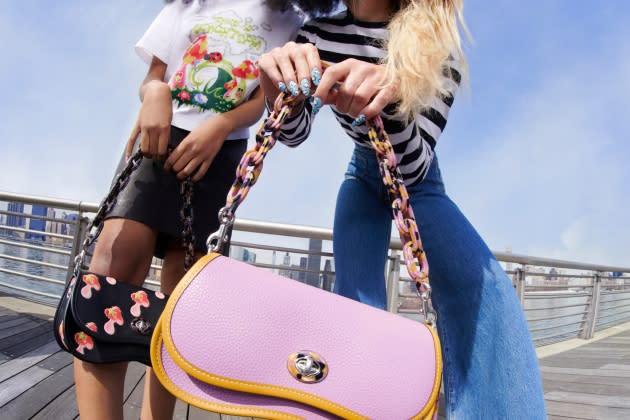Tapestry Beats Expectations in Q3, Raises Expectations

Tapestry Inc.’s strategy to zero in on a younger customer is paying dividends as the parent of Coach, Kate Spade and Stuart Weitzman reported earnings per diluted share ahead of expectations and a sales gain of 5 percent, or 9 percent on a constant currency basis, in its fiscal third quarter.
This led the company to raise its full-year guidance and pleased Wall Street, which sent the stock up 8.3 percent to close at $40.21 on Thursday.
More from WWD
In the period ended April 1, Tapestry posted net income of $187 million, or 78 cents a share, up from $123 million, or 46 cents a share, and sales rose to $1.51 billion from $1.44 billion a year ago. The FactSet consensus was for EPS of 60 cents and sales of $1.44 billion, according to MarketWatch.
By division, sales at Coach rose 7 percent, or 11 percent on a constant currency basis, to $1.14 billion, while Kate Spade sales were down 1 percent to $297.2 million and Stuart Weitzman sales rose 7 percent, or 10 percent on a constant currency basis, to $68.3 million.
The company is now expecting full-year revenue of about $6.7 billion, and EPS of $3.85 to $3.90. The FactSet consensus is for EPS of $3.72 and revenue of $6.6 billion. This assumes no further appreciation of the U.S. dollar, continued gradual recovery in Great China from COVID-19-related disruptions and no material worsening of inflationary pressure or consumer confidence, according to the company.
Joanne Crevoiserat, chief executive officer, told WWD that the strength of the numbers was a “real testament that our strategy is working.” She pointed to the strong international growth, expansion of gross margins and earnings per share that were more than 50 percent ahead of plan as highlights of the period.
“We delivered solid revenue gains, expanded both gross and operating margin, and drove robust earnings growth,” she said. “Importantly, we continued to advance our strategic agenda, creating lasting customer relationships around the world through product innovation and compelling omnichannel experiences.”
Crevoiserat added that Tapestry is “well positioned to deliver sustainable, profitable growth against a volatile backdrop” in the future by sticking with the same game plan. “We’re harnessing the strength of our iconic brands, enhanced by our direct-to-consumer, globally diversified and data-driven platform. At the same time, we’re continuing to make investments that fuel brand magic and empower us to move at the speed of the consumer both today and for years to come.”
During the quarter, the company said, Tapestry acquired more than 1.2 million new customers in North America, more than half of them Gen Z and Millennials. Sales in the region increased in the low-single digits, ahead of expectations, in what Crevoiserat characterized as “an increasingly challenging consumer backdrop.”
Outside the U.S., the corporation posted a sales gain of 5 percent led by strength in Greater China where business grew about 20 percent and in Japan and other parts of Asia, where sales jumped more than 20 percent. In Europe, the sales gain was 4 percent.
In China, a special collection of rabbit-themed bags tied to the Lunar New Year helped the brand attract new customers, with more than half the purchasers being new to the brand, Crevoiserat said.
By channel, direct-to-consumer sales rose about 10 percent with a low-teen increase in stores and a mid-single-digit gain in digital with both expanding operating margin compared to the prior year, the company said.
Crevoiserat said the Coach brand was a “really standout performer” in the period. Among the bestsellers in the quarter was the Tabby bag, a staple for the company, that Crevoiserat said resonated with both new and existing customers. The core shoulder bag continued to be popular along with the new box bag and the jelly model. The Rogue bags, especially popular with young customers, gained momentum while the Bandit outperformed at higher price points, she said.
In men’s, the Gotham collection did well, as did the launch of a tote in a range of colors featuring Coach New York graphics. Small leather goods also found their fans, with wallets and micro-bags selling well in the period. And the ready-to-wear collection “delivered outsized growth” in all genders, Crevoiserat said, led by strength in outerwear, particularly the trenchcoat.
In the period, the company launched Coach Play in Chicago, Tokyo and Singapore, a series of concept stores that encourage customers to “play in Coach spaces,” she said, along with Tabby shops in select stores around the world.
Todd Kahn, CEO of Coach, said these Tabby shops, in Coach-owned stores as well as other retailers, are designed as “fun, experiential ice cream shops” that have proven popular with customers and offer a point of differentiation in malls and other locations.
Best of WWD

